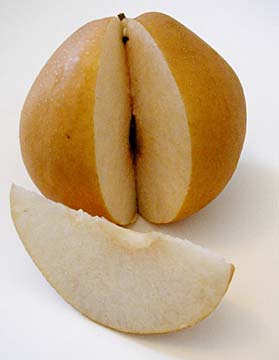

Key Ingredient

|
Probably the best known Asian pear variety is the 20th-century nashi, or nijisseiki. When it first entered the U.S. market, it was considered quite a delicacy and commanded a hefty price. Today, a number of Asian pear varieties fill the stands at this time of the year at more affordable prices.The basics: Asian pears, also called nashi or apple pears, originated in Asia -- mainly China, Japan and Korea. Hundreds of varieties are grown, but only a handful are available in this country.
Asian pears differ from European pears both in appearance and taste. Their crunchy and juicy texture resembles apples, but they have no relation to apples. Most are round, with skin color ranging from light yellow to russeted brown. The flesh is yellowish-white with a sweet, crisp and juicy texture.
Like European pears, Asian pears are harvested in the fall and are available until early spring. They don't need additional ripening, as do some European varieties.
Varieties that have increased in popularity here are the giant Korean pears (or shingo variety) and hosui, a smaller, brown-skinned pear that is said to be sweeter and more flavorful than the nashi. Also popping up is the No. 1 Chinese pear variety, ya li. The ya li has a more traditional pear-like shape with a very thin skin.
Selecting: Choose fruit that is heavy for its size and firm but not rock hard. Asian pears bruise and brown very easily so they are sometimes sold wrapped in paper or some form of cushioning. Watch out for soft spots and dark holes.
Storing: Pears should be stored in the refrigerator and will keep for a week or so.
Use: Unlike European pears, Asian pears don't fare very well when cooked and are best enjoyed fresh. In Asia, these pears are cored and quartered like apples and often served for dessert. In the United States they are increasingly being incorporated into salads.
Asian pears don't brown as readily as European pears when cut, so they may be served in slices on an antipasto platter with prosciutto and artisan cheeses or simply tossed with greens, walnuts and blue cheese for a hearty salad. The skin can be left on or peeled, depending on your preference.
Where to buy: Asian pears should be available for the next month or so in most markets. Prices range from $1.79 to $2.99 a pound.
Food Stuffs: Morsels
Eleanor Nakama-Mitsunaga is
a free-lance food writer. Contact her
online through features@starbulletin.com